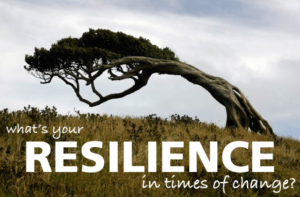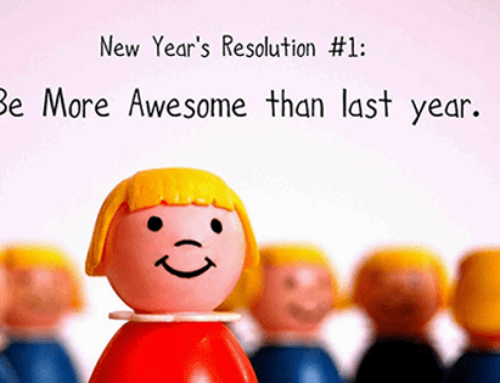“It is not the strongest of the species that survives, nor the most intelligent,but the one most responsive to change.”
– Charles Darwin (1809-1882), English naturalist and geologist, best known for his contributions to evolutionary theory
 Individual Resilience is how humans adapt to change. It’s like a tree in a storm: some trees (like a live oak) bounce back from the force of the wind, looking like nothing has happened. Other trees (like a pine tree) aren’t so flexible, and after constant winds branches break or the tree stays bent. People are like that too: some bend in times of change and snap back while others break, get damaged, or never fully recover.
Individual Resilience is how humans adapt to change. It’s like a tree in a storm: some trees (like a live oak) bounce back from the force of the wind, looking like nothing has happened. Other trees (like a pine tree) aren’t so flexible, and after constant winds branches break or the tree stays bent. People are like that too: some bend in times of change and snap back while others break, get damaged, or never fully recover.
While there’s a lot of conversation in the “change management” circles about the process of change, you don’t hear enough about how to set people up for success when change occurs, or how to help them be resilient, ready for the winds of change. But there’s a lot of great research out there on how us humans react to change from a variety of fields; let’s explore just one of these ideas on resilience.
Change Management researchers Dr. Linda Hoopes and Mark Kelly looked at over thirty years’ worth of change management data and identified the key variables that make individuals successful in times of change. They looked at why Person A thrived and grew in times of change and why Person B crashed and burned in the same time. They found that the people who thrived and grew had high competence in seven specific areas, and they dubbed these the 7 Aspects of Individual Resilience. In theory the higher we are in these seven areas the better we are at surviving — and thriving — in times of change.
#1: Positive View of the World
Hoopes and Kelly found that how we look at the proverbial glass — be it half empty or half full — can determine how well we bounce back in times of unanticipated change.
Studies show that individuals with a more positive view of the world are much more resilient than those who are a bit more of that “Debbie Downer.” Even when the chips are down, those individuals with higher resilience can see the silver lining in the clouds, and remember the positive in the bleakest of times. They found that those who have a more positive view of the world:
- See the value in new opportunities
- Look for the good in even the worst situations
- Are generally upbeat about the future possibilities
3 TIPS FOR IMPROVING THIS ASPECT OF RESILIENCE:
- Identify 5 things that went “well” for you each day (write them in a journal or on your smartphone). After about 2-3 months you will shift your perspective; having put yourself on the spot to find the good things each day.
- Reflect on your life milestones and plot them on a graph with “good” or positive things above the middle line and “bad” or negative things below. Ask yourself, “in these ‘down times’ what did I do to get back up?” Remember these the NEXT time things get tough.
- Explore apps like Happify to boost your daily outlook on life in a positive manner.
#2: Positive Self-Concept
While a “positive view of the world” looks outward, Aspect #2 Positive Self-Concept is about looking inward and being positive about what you see.
Hoopes and Kelly found that those individuals who have a favorable view of themselves, understand what they “can do,” and have the confidence to success — even in the toughest of times — are much more successful in times of change than those who don’t have as much self-esteem. They found that those with a more positive self-concept:
- See themselves as a valuable, capable people
- Feel equipped to deal with whatever comes their way
- Do not feel victimized by circumstances (especially in times of change); and
- See their actions as being able to influence others
3 TIPS FOR IMPROVING THIS ASPECT OF RESILIENCE:
- Take inventory of your resources (here we mean those strengths, skills, or abilities you possess). What do you “bring to the table”?
- Identify one skill you want to improve, and make time in you calendar for it. Schedule a “recurring meeting” with yourself to stick to it.
- Explore apps like Mindfit to boost your self-esteem and positive self-view.
#3: Focus Sense of Purpose
People with lower resilience (according to Hoopes and Kelley) haven’t defined their purpose, nor do they work toward that purpose. People with that focused sense of purpose — be that vocationally (“I’m going to be a rockstar teacher!”) or personally (“I’m going to be the best mother in the universe!”) tend to bounce back in times of change.
Why? Because they know where they’re going: when change diverts them off-course they can quickly re-calculate their heading and get back on track. These individuals have thought about their personal values system and make sure it’s being “fed” by activities both home and/or at work, and when those values aren’t being met they find ways to do that. Those less resilience are spending energy wasted on activities that don’t “feed their values,” and then have little resources to focus on managing the change at hand. Resilient people:
- Tend to have long-term goals
- They are committed to achieving those goals; and
- They use those goals and their values to guide their actions
3 TIPS FOR IMPROVING THIS ASPECT OF RESILIENCE:
- Identify your Top 5 Personal Values, and be sure to rank them in the order starting with the highest. Then think about what you do on a daily or weekly basis. Do the things on your “to do” list somehow connect with feeding your values? If yes, great; keep it up. If not: think about what you could do differently to feed those values.
- Think about your “strongest” part of your day, when you are most focused. Now think about that “to do” list (see #1, above). For those things that require the most focus make sure you schedule them during your “sharpest” part of your day (I’m best in the morning, so I work on my hardest jobs there. Easier stuff — especially things that feed my values — I do at other times because they take less focus and I enjoy doing them).
- Check out apps like Lumosity which — according to neuroscientists — helps your exercise your brain for better focus, memory, and cognition (“it’s a work out for your brain.”).
#4: Flexible Thinking
It’s too often said to “think outside the box!” But according to Hoopes and Kelley, people who tend to think in a creative or “flexible” manner tend to be much more successful in times of change.
Think about it: change brings on unknown and uncertainty. We don’t have all the answers. Resilient people can think through the various scenarios and responses they need in order to survive (and thrive) in this new change. Less resilient people just focus on the “this way or that way” mentality without seeing the options and flexibility of the situation. Less resilient people see only “black or white,” while resilient folks see the shades of gray in change. Our more resilient friends:
- Tend to enjoy new, complex ideas
- Are open to different perspectives; and
- Generate create solutions for adapting to change
3 TIPS FOR IMPROVING THIS ASPECT OF RESILIENCE:
- When faced with a problem, attack it by listing the positives of the issues and then the negative. Try and force yourself to look at the change or issue from various angles and see what comes up.
- Find a hobby that evokes creativity, even if no one else sees or hears the fruits of your work. In the book “Imagine: How Creativity Works” by Jonah Lehrer he notes how several experts in their fields — from Yo-Yo Ma to Michael Jordan — have their “ah-ha!” moments when doing something outside their norm. Get out of your norm and create.
- Explore using “creativity jump starter” apps like Oflow to get your creative juices flowing.
#5: Social Flexibility
Aspect #2: Positive Self-Concept explores how we know what “resources” we each possess; it also is where we identify what resource maybe we don’t possess or don’t have the highest competence in it. Aspect #5: Social Flexibility is where we draw on the resources of others in times of change. Resilient people (according to Hoopes and Kelley) realize that other people supplement our skills and knowledge in the changing times, and together we are much stronger, smarter, and resilient than being alone.
When people with lower resilience “go it alone” they tend to have blind spots, feel isolated, and that the change occurring is all about them and not impacting anyone else. Conversely, our resilient friends realize that the change at hand is typically complex, and gaining the perspective and resources of others will help make everyone successful. With regard to Social Flexibility, resilient people:
- Tend to recognize where others add value
- Work well in team settings
- Draw on others for support
3 TIPS FOR IMPROVING THIS ASPECT OF RESILIENCE:
- With building Social Flexibility, diversity is key. Look at your teams at work, your circle of friends at home, and look at their demographics. Are they pretty homogeneous, or a diverse group? Resilient people have a diverse network with which to solicit new and different ideas from their own, consider expanding your own as needed.
- Identify 2-3 “trusted advisors” that you can confide in when facing changing times. Look for people who will challenge your train of thought, provide alternative perspective, and maybe make you second-guess your thoughts. Have an agreement that your roles are to make each other think from a different perspective.
- Using social media, follow and engage in people who have different views than yourself. Ask them to explain their side of the story, and you to share yours. Keep an open mind and watch your emotions as you engage; often we go to that “emotional space” when our ideas and opinions are questioned.
#6: Organizing Ambiguity
Ahhh the big, ugly, scary, black holes of change. Often the fear of the unknown is why people don’t like change: it’s fundamentally a safety issue from our caveperson programming. When we were cave people we had “safety!” in mind. When our ancestors didn’t have all the facts (“I’ve never encountered that sharp-toothed animal before!”) discomfort and red flags alerted us of potential danger for our own survival. As creatures, humans don’t like not knowing, and that still exists in our comfy workplaces today.
So how do highly resilient people handle ambiguous situations? Hoopes and Kelley say that the most resilient of us deal with these black holes effectively and within context. They focus on understanding what is both “known” and “unknown” and developing their plan from this data. They also look at how they can use this organizational approach to help others through the change. And these more resilient folks focus on what they can control, what they can influence, and identify what to do when things during the change aren’t within their control nor influence. People who are good at Organizing Ambiguity:
- Can sort information and data quickly
- Are able to identify patterns in new situations
- Effectively build structure from chaos
3 TIPS FOR IMPROVING THIS ASPECT OF RESILIENCE:
- Think about how you organize things in your day-to-day life. What works best for you? Apply these personal “best practices” when dealing with ambiguous situations of change.
- How do you eat an elephant? One bite at a time! With especially complex change situations (which, frankly, are most) determine your small wins to make the change happen. Identify key milestones to success (“I just will get healthier first by walking every day!” … then “Now I’ll start to eat more healthy!”). Be sure to start with the end result in mind FIRST and work backwards toward meeting that goal. You can say “I’ll lose 40 pounds before my reunion” and it’s next week.
- Consider using organization apps such as Evernote or Things to help you keep organized and remember to get things done.
#7: Proactive Experimentation
Do you like to cook? Yes? Well do you follow the recipe each time? No? Then congrats: you’re most likely really good at Proactive Experimentation! Hoopes and Kelley say that those people who engage in this type of behavior — trying out hobbies, test the waters for new ideas, and don’t fall into “analysis paralysis” or checking every aspect of a plan perfectly before action are much more resilient than others.
If you think about it, Proactive Experimentation involves all the other aspects of resilience: you typically engage in an experiment to learn more (#6: Organizing Ambiguity), you Flexibly Think (#4) about a solution and have a Focus Sense of Purpose (#3) to to engage in the experiment, you know what skills and resources you need (#2: Positive Self-Concept), but engage others for their thoughts and opinions (#5: Social Flexibility). And if your experiment fails? You learn from the mistakes (#1: Positive View of the World) and try again. So, those more resilient individuals:
- Test their ideas in practice
- Take reasonable risks
- Try new activities (including new hobbies, travel destinations, or work assignments)
3 TIPS FOR IMPROVING THIS ASPECT OF RESILIENCE:
- Start small. Think of a small experiment you can play with to test your ideas. Think you want to move abroad? Start small: take a holiday to that country and test it out. Starting small helps you identify where you’ll most likely be successful in your experiment, and where you might need more resources.
- In your change situation, ask yourself: “What’s the worst that can happen?” Here we’re trying to mitigate the risk level.
- Think about things from a win-win situation. If you truly fail at the experiment, what do you still gain from it? Knowledge? Stronger relationships? Exposure?
So: where to start?
The best approach to increase your personal resilience to change is to analyze and energize. Think about each of the seven aspects in relationship to a battery: the higher your resilience level in, say, #1: Positive View of the World, the higher your battery juice. So first do some assessment and rate yourself on a 10-point scale on how high your “battery juice” is for each of the 7 Aspects of Resilience.
Once you’ve analyzed your levels, look for the lower batteries and make a plan to take actions to increase your resilience in those specific areas. Don’t focus on more than 1 or 2 at a time, and commit to developing these areas over time (a one-day “quick fix” won’t bring lasting change to yourself, no more so than going to the gym once doesn’t get you “swimsuit ready” in time for summer). Commit to building your resilience step by step and you’ll find yourself able to not just survive but thrive in times of change.
* adapted from “Managing Change with Personal Resilience: 21 Keys for Bouncing Back & Staying on Top in Turbulent Organizations” by Dr. Linda Hoopes and Mark Kelley (2003).






